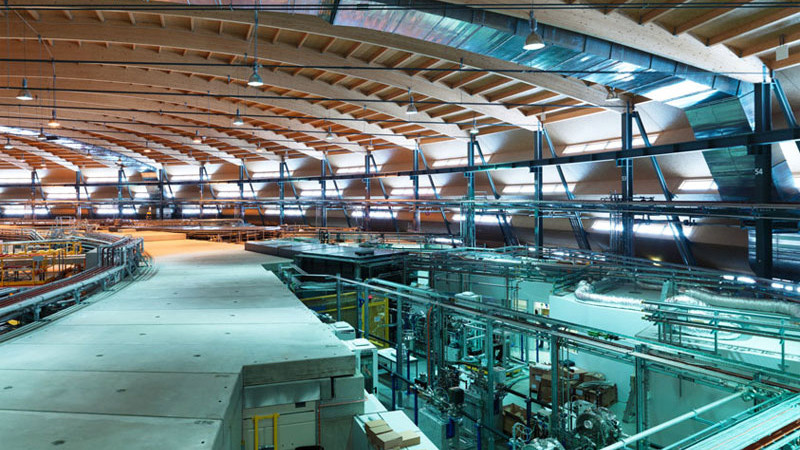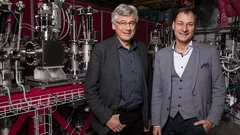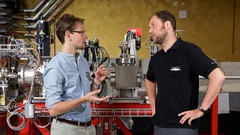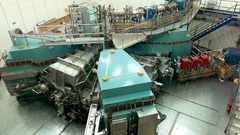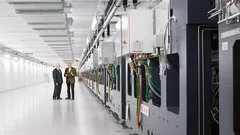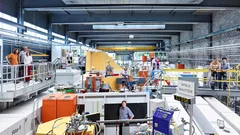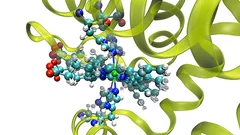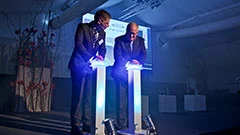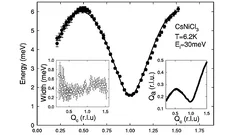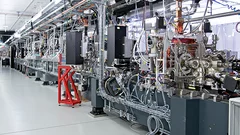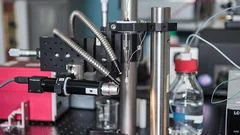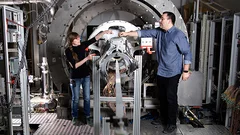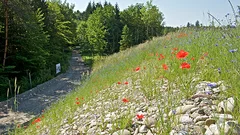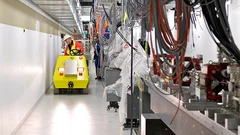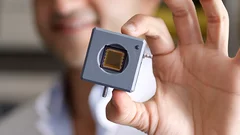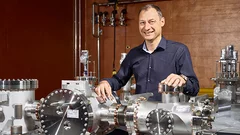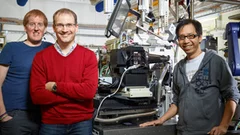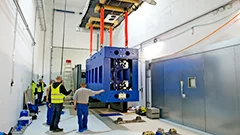Large Research Facilities
Sometimes, one needs unusually large pieces of equipment to look at the smallest of objects – because only these large machines or facilities can generate the probes
that are needed to examine matter in such a way that the information being sought can be obtained. PSI maintains a number of such facilities, making them available as a service for other institutions, but also using them for its own research. These facilities are unique within Switzerland, and PSI is the only location in the world for some of the facilities
Read more at: Large Research Facilities
Further information
First experiment at SwissFEL carried out successfully
The years of careful planning and construction have paid off: At the newest large-scale research facility of the Paul Scherrer Institute PSI – the X-ray free-electron laser SwissFEL – the first experiment has been carried out successfully. With that, two goals have been achieved: First, a new scientific result is already expected. Second, the interaction of the many individual components of the highly complex facility is being optimised.
Research experience from California benefits Swiss X-ray free-electron laser SwissFEL
An X-ray free-electron laser (XFEL) is capable of visualizing extremely fast structural and electronic processes. Pilot experiments will take place at the PSI's Swiss Free-Electron Laser (SwissFEL) from the end of 2017 on. Two current publications in Science and Nature Communications demonstrate the kind of outstanding scientific work that is enabled by such facilities. The work was carried out at the Linac Coherent Light Source (LCLS) in California. Two of the leading authors behind these studies have now relocated to the PSI in order to share their expertise as SwissFEL expands its capabilities.
Injector 2: a pre-accelerator for protons
As fundamental building blocks of matter, protons are part of all the things that surround us. At the Paul Scherrer Institute PSI, though, they step out of their usual role and are deployed to generate other particles, namely neutrons and muons, which are then used to study materials. But for that, the protons first have to be accelerated. An important role in this is played by a three-stage accelerator facility, in the middle of which stands the accelerator known as Injector 2.
To the limits of the feasible
The company Daetwyler made the undulators for the X-ray free-electron laser SwissFEL of the Paul Scherrer Institute PSI, to a precision of one-tenth of the width of a hair.
Successful for 20 years: Probing materials with particles
Whether they study materials for the electronics of the future, batteries, or swords from the Bronze Age — for 20 years researchers from a range of disciplines have been using the Swiss Spallation Neutron Source SINQ of the Paul Scherrer Institute PSI for their investigations. At a symposium on 18 April, researchers looked back on the facility's successes and presented plans for modernisation.
Second beamline for SwissFEL
This year the first pilot experiments are starting at the X-ray free-electron laser SwissFEL. The X-ray light generated by SwissFEL will enable a broad spectrum of experiments. Beginning in 2020, a second beamline will provide for a still greater variety.
SwissFEL inauguration
Today, on 5 December 2016, the Paul Scherrer Institute PSI held an inauguration ceremony for its new large-scale research facility SwissFEL, with Johann N. Schneider-Ammann, President of the Swiss Confederation, in attendance.
Physicists at the PSI’s large-scale research facilities are thinking beyond the Nobel Prize theories
This year’s Nobel Prize for Physics goes to David Thouless, Duncan Haldane, and Michael Kosterlitz. The Academy also cited, in its background report, experiments carried out by Michel Kenzelmann, who today is a laboratory head at the PSI. He and other researchers at the PSI continue to do experiments based on the theories now honoured by the Nobel Prize.
SwissFEL in the home stretch: The first electrons are here
SwissFEL building, 24 August 2016: In the control room above the beam tunnel of the X-ray free-electron laser SwissFEL, the atmosphere is intense and focussed. Marco Pedrozzi’s team has big plans for this late August afternoon. The last adjustments have been made — it’s time to press the big button and start up the electron source. The goal: SwissFEL should generate its first electrons. A report.
Catching proteins in the act
Proteins are indispensable building blocks of life. They play a vital role in many biological processes. Researchers have now been able to show how the ultrafast processes by which proteins do their work can be studied with free-electron X-ray lasers such as SwissFEL at the Paul Scherrer Institute PSI. Free-electron X-ray lasers generate extremely short and intense pulses of X-ray light. Currently there are just two such facilities in operation, worldwide. The results were published in the scientific journal Nature Communications.
Zebra - a new instrument for the PSI
Interview with Oksana ZaharkoNew scientific questions demand ever better experimental equipment. In this interview, PSI researcher Oksana Zaharko reports on the challenges of setting up a new instrument for research with neutrons.
Five hundred thousand times less likely than winning the lottery
Measuring the rarity of a particle decayIn the so-called MEG experiment at the PSI, researchers are searching for an extremely rare decay signature from a certain kind of elementary particles known as muons. More precisely, they are quantifying its improbability. According to their latest number, this decay occurs less than once in 2.4 trillion events. By means of this result, theoretical physicists can sort out which of their approaches to describing the universe will hold up against reality.
Cooperation with nature
With SwissFEL, a new landscape takes shapeBarely completed, the building housing the X-ray free-electron laser SwissFEL has disappeared again beneath a mound of earth. Since then, planting and landscaping have been under way on and around this major research facility of the Paul Scherrer Institute PSI. Its special location, in a forest, demands that SwissFEL be integrated in an environmentally appropriate way. So the facility is, from the outside, nearly invisible. And rare animals and plants have gained new living space.
To the beam tunnel
Since the autumn of 2015, the SwissFEL beam tunnel has been filling up with the machine components for the new PSI large research facility. Piece by piece, the pre-assembled components are being brought to their final destination.
X-ray research in the UFO
At first glance, the Swiss Light Source SLS stands out as a striking building. The inside reveals a setting of cutting-edge research. A journey through a world where electrons race a slalom course and X-rays help decode proteins.
Put in perspective
Researchers from the Paul Scherrer Institute PSI have succeeded in using commercially available camera technology to visualise terahertz light. In doing so, they are enabling a low-cost alternative to the procedure available to date, whilst simultaneously increasing the comparative image resolution by a factor of 25. The special properties of terahertz light make it potentially advantageous for many applications. At PSI, it will be used for the experiments on the X-ray free-electron laser SwissFEL.
Perfect beamlines go unnoticed
Interview with Luc PattheyLuc Patthey is in charge of designing and implementing the beamlines for the X-ray free-electron laser SwissFEL. In this Interview, he explains the requirements the beamlines need to meet for the X-ray light pulses generated by SwissFEL to reach the experiments in an optimal form and what role collaborations play in the development of beamlines.
Together, not alone
Decoding biomolecules at SwissFEL and SLSProteins are a coveted but stubborn research object. A method developed for x-ray free-electron lasers and PSI’s future SwissFEL should now help researchers to make good headway in this field. It involves x-raying many small, identical protein samples consecutively at short intervals, thereby avoiding the main problem that protein research has faced thus far: producing samples in a sufficient size.
First undulators reach the SwissFEL building
The first undulator frames have arrived at the SwissFEL building. They will take around six months to assemble, after which the finished undulators will be taken to the SwissFEL accelerator tunnel for installation.
From inside an eggshell
Tiny cavities inside eggshells supply the materials that stimulate and control the shell’s growth. Using a novel imaging technique, researchers from the Paul Scherrer Institute (PSI), ETH Zurich and the Dutch FOM Institute AMOLF have succeeded in depicting these voids in 3D for the first time. In doing so, they lift an old limitation of tomographic images and hope that one day medicine will also benefit from their method.
